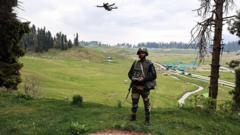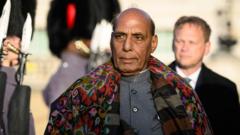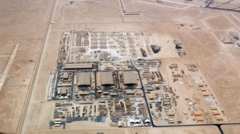Tensions between India and Pakistan intensify as both nations engage in unprecedented drone warfare. Experts warn of the implications as unmanned technologies reshape the dynamics of conflict, questioning the potential for escalation amidst nuclear capabilities.
Rising Tensions: The Dawn of Drone Warfare in the India-Pakistan Conflict

Rising Tensions: The Dawn of Drone Warfare in the India-Pakistan Conflict
The India-Pakistan rivalry escalates with the introduction of drones, marking a historic shift in military strategy and potential confrontation.
The world's first drone war between nuclear-armed nations has emerged in South Asia, with escalating tensions marking a historic shift in the India-Pakistan conflict. On Thursday, India accused Pakistan of launching a series of drone and missile strikes on military bases within Indian territory, specifically in the region of Jammu and Kashmir, to which Pakistan responded by asserting it had countered these attacks by downing 25 Indian drones.
This tit-for-tat, according to military analysts, suggests a perilous new chapter in the longstanding rivalry, introducing unmanned aerial vehicles (UAVs) into the operational theater, where precision and stealth become pivotal. "The Indo-Pak conflict is evolving into a new era of drone warfare where the mastery of unmanned tactics will dictate operational outcomes,” claims Jahara Matisek, a defense expert at the US Naval War College.
Recent reports indicate that air and cross-border assaults have resulted in numerous casualties, including 36 deaths and 57 injuries in Pakistan and its administered territories, while India fights claims that it faced retaliatory shelling leading to 16 civilian casualties. India justified its assaults, citing revenge for recent militant attacks on Indian tourists, which Pakistan vehemently denies orchestrating.
Pakistan’s military also reported the successful interception of Indian drones across cities including Karachi and Lahore, using technical measures and weaponry. While India has contended that it disabled several of Pakistan’s drone defense systems, these claims have met with rebuttal from Islamabad.
The significance of drone technology, specifically models from Israeli manufacturers such as the Harop, underscores a strategic pivot towards high-precision warfare. Drones are being utilized not just for reconnaissance, but also to infiltrate enemy airspace and pinpoint targets, significantly changing the dynamics of warfare in South Asia, experts note.
India's reliance on varied UAV systems, such as the IAI Searcher and Heron, showcases advancements in their aerial combat capabilities. A major $4 billion deal to acquire 31 MQ-9B Predator drones from the United States represents a leap in India’s military prowess, allowing extended flight persistence and high-altitude operations.
Contrastingly, Pakistan’s arsenal consists of over a thousand drones acquired from diverse sources, including advanced models from China and Turkey. The evolution of drone warfare tactics continues, with both nations developing loitering munitions and integrated air combat solutions to bolster their defenses.
As the crisis develops, experts discern a cautionary tale of potential escalation versus restraint in the air, likening it to drone warfare tactics observed in other global conflicts. While current actions may appear restrained, they could foreshadow broader aerial campaigns. Analysts express concerns that every intercepted drone or downed aircraft may pose additional risks for further retaliatory strikes in this volatile environment.
In conclusion, both nations find themselves at a critical juncture, navigating drone technology's impact on military strategy and the potential for future conflict. As drone operations proliferate, the balance between action and restraint presents profound implications for stability in the region.





















